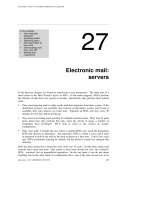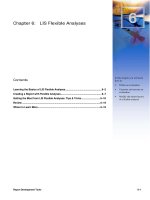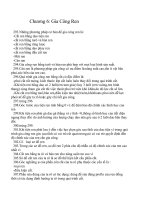Tài liệu Chapter 6: Carbon-carbon bond formation pptx
Bạn đang xem bản rút gọn của tài liệu. Xem và tải ngay bản đầy đủ của tài liệu tại đây (928.68 KB, 28 trang )
Chapter 6
Carbon-carbon bond formation
Synthetic organic chemistry is equivalent to systematic making and
breaking chemical bonds of which the manipulation of carbon-carbon bonds
plays an extraordinary role in construction of an organic molecule.
Traditionally this chemistry was carried out in organic solutions, however,
water or partially aqueous solvents gain more and more significance in
organic synthesis recently. To attempt a comprehensive description of this
field would be a hopless venture these days, and this chapter gives only
examples of the most important ways of carbon-carbon bond formation in
aqueous media. Non-catalytic reactions are discussed in several books and
reviews published in the last ten years [1-6] and here we shall focus on
catalysis of C-C bond formation or rupture by transition metal complexes. In
most cases, the studies which give the basis of this brief account were
motivated by the aims of synthesis and mechanistic details were hardly
scrutinized. Consequently, although in several reactions the presence of
water was found essential in order to obtain good yields or selectivities
explanations of these observations often remain elusive.
Carbon-carbon cross-coupling reactions, such as the Heck, Suzuki,
Sonogashira, Tsuji-Trost and Stille couplings are important synthetic
methods of organic chemistry and were originally developed for non-
aqueous solutions. It has been discovered later that many of the reactions
and catalysts do tolerate water or even proceed more favourably in aqueous
solvents. The development and applications of these processes in aqueous
media is more specifically reviewed in references [7-11]. It is characteristic
of this field that the content of the solvent may vary between wide
boundaries, from only a few % to neat water. The other characteristic
feauture is in that with a very few exceptions the catalyst is based on
palladium with or without tertiary phosphine ligands. Water-soluble
phosphines (for example TPPTS and TPPMS) are often used as ligands in
209
210
Chapter 6
these catalysts. However, in the most popular mixed aqueous-organic
solvents (prepared with acetonitrile, butyronitrile or benzonitrile) this may
not be necessary since or have sufficient solubility in these
mixtures.
6.1 Heck reactions in water
Vinylation or arylation of alkenes with the aid of a palladium catalysts is
known as the Heck reaction. The reaction is thought to proceed through the
oxidative addition of an organic halide, RX onto a zero-valent
species followed by coordination of the olefin, migratory insertion of R,
reductive elimination of the coupled product and dehydrohalogenation of the
intermediate (Scheme 6.1).
or the complexes formed from it with tertiary phosphines can
serve as catalysts (precursors), but
(DBA = dibenzylidene acetone) or can also
be used. It is well known that in the presence of water phosphines efficiently
reduce Pd(II) to Pd(0).
In accordance with the suggested mechanism aryl iodides react easily
(Scheme 6.2). At 80-100 °C, iodobenzene and acrylic acid gave cinnamic
acid in neat water with as catalyst and a mix of and
as base [12]. Similar reactions were run in water/acetonitrile 1/1 with
Carbon-carbon bond formation
211
the well-characterized complex [13]. The in situ prepared
Pd/TPPTS catalyst was effective for both inter- and intramolecular
couplings at room temperature [14]. In the latter case the solvent contained
only 5 % water. However, even this limited amount of may be very
important for an efficient reaction. It was observed, that in dry acetonitrile
the reaction of iodobenzene with methyl acrylate proceeded sluggishly even
in the presence of tetrabutylammonium salts, and under given conditions
gave only 15 % of methyl cinnamate. In contrast, when a 10/1
solvent mixture was used the yield of methyl cinnamate exceeded 96 % [15].
Despite the fact that aryl bromides are generally less reactive, o- and p-
bromotoluenes could be efficiently vinylated with ethene in with
as catalyst and as base [16]. With careful
choice of reaction parameters (90 °C and 6 bar of ethene) all bromotoluene
was converted to high purity ortho- or para-vinyltoluene. Under the
conditions used, the reaction mixture forms two phases. In this case the main
role of water is probably the dissolution of triethylamine hydrobromide
which otherwise precipitates from a purely organic reaction medium and
causes mechanical problems with stirring.
Running a Heck reaction in an aqueous phase may substantially change
the selectivity of the process as demonstrated by the cyclization of iodo- and
212
Chapter 6
bromodienes [17]. Under non-aqueous conditions such reactions usually
afford the exo-product. Indeed, in anhydrous cyclization of the
diallylamine derivative (Scheme 6.3) proceeded with 100% regioselectivity
towards the formation of the exo-product. Conversely, in 6/1
the same reaction produced a 65/35 mixture of the endo/exo heterocycles.
In the cyclization of the (iodoaryl)diene, N-methyl-N-(1,5-hexadiene-3-
yl)-2-iodobenzoic acid amide, the combined yield of the tricyclic products
arising from a double intramolecular Heck reaction reached 52 % when the
catalyst was prepared from and 1,10-phenanthroline and the
reaction was run in ethanol/water 1/1 (Scheme 6.4) [18,19]. Interestingly, in
the reaction did not proceed at all with this catalyst. It is also
noteworthy, that Pd-phenanthroline complexes are rarely used as catalysts in
Heck-type reactions.
Unsaturated branched-chain sugars were synthetized with 72-84 % yield
from both protected and unprotected 2-bromo-D-glucal with methyl acrylate
in 5/1 or in 5/1 with a catalyst prepared from
and or could be used as
base with similar results.
Carbon-carbon bond formation
213
The palladium complex of the dibenzofuran-based water-soluble tertiary
phosphine 49 was found catalytically active for the internal Heck reaction of
Heck reactions of arenediazonium salts can be conveniently carried out
with in ethanol. This method was extended to the one-pot
sequential diazotation and allylation of anilines (Scheme 6.7). The latter
were converted to the corresponding diazonium salts at 0 °C with
Ethyl acrylate and were added and the reaction
mixture was heated on a water bath for 1 h. The corresponding cinnamate
esters were obtained in 65-80 % yield [22].
This method of obtaining cinnamate esters directly from anilines has
useful features. It is simple and the yields are comparable to those obtained
with isolated diazonium salts. However, in this case isolation of the latter is
not required, what is most beneficial in case of unstable diazonium salts,
N-allyl-o-iodoaniline in 1/1(Scheme 6.6) [21].
214
Chapter 6
such as the one formed from anthranilic acid. It is to be noted, however, that
the reaction is successful only if is used for diazotation; with HCl the
aqueous one-pot procedure fails.
6.2 Suzuki couplings in aqueous media
In general terms Suzuki coupling refers to the reaction of organic halides
with boronic acids and boronates (Scheme 6.8). These compounds are fairly
stable to hydrolysis, so application of aqueous solvents [7-11] is quite
straightforward.
The reaction is catalyzed by palladium complexes either pre-formed, as
[13], or prepared in situ from (usually) and
various phosphines [21,23-27], TPPTS being one of the most frequently
used [14]. Other precursors, e.g. and so-called ligand-
less (phosphine-free) Pd-catalysts can also be effective. In fact, in several
cases a phosphine inhibition was observed [23]. The solvent can be only
slightly aqueous (5 % water in [14]) or neat water [26]. In the latter
case a biphasic reaction mixture (e.g. with toluene) facilitates catalyst
separation albeit on the expense of the reaction rate. A short selection of the
reactions studied in aqueous solvents is shown on Scheme 6.9.
Special mention has to be made of the use of surfactants. Aryl halides are
insoluble in water but can be solubilized in the aqueous phase with the aid
of detergents. A thorough study [24,25] established that the two-phase
reaction of 4-iodoanisole with phenylboronic acid (toluene/ethanol/water
1/1/1 v/v/v), catalyzed by was substantially
accelerated by various amphiphiles. Under comparable conditions the use of
CTAB led to a 99 % yield of 4-methoxybiphenyl, while 92 % and 88 %
yields were observed with SDS and respectively (for the
amphiphiles see Scheme 3.11). Similar effects were observed with Pd-
complexes of other water-soluble phosphines (TPPTS and TPPMS), too.
With palladium catalysts aromatic chlorides are rather unreactive,
however, nickel is able to catalyze the reactions of these substrates, too. The
water-soluble catalyst was generated in situ from the easily available
and an excess of TPPTS by reduction with Zn in mixtures of
1,4-dioxane and water. Although it had to be used in relatively large
quantities (10 mol %), the resulting compound catalysed the cross-coupling
Carbon-carbon bond formation
215
of chloroaromatics with phenylboronic acid (Scheme 6.10) [28]. Sulfur-
containing reactants did not poison the catalyst so thienylboronic acid could
also be applied.
Activated tiophenes were coupled with iodoarenes with phosphine-free
Pd-catalysts in 9/1 [29].
2-Chlorobenzonitrile was coupled with p-tolylboronic acid affording the
important pharmaceutical intermediate 2-(p-tolyl)benzonitrile in good yield
216
Chapter 6
phosphonato-phosphine in water/ethyleneglycol and a
In a modified version of the Suzuki reaction arylboronates or boranes are
utilized instead of arylboronic acid. Under the action of phosphine-free
palladium catalysts and tris(1-naphtyl)borane were found suitable
phenyl-sources for arylation of haloaromatics in fully or partially aqueous
solutions at 20-80 °C with good to excellent yields (Scheme 6.12) [32-34].
Aryl halides can be replaced by water-soluble diaryliodonium salts,
in the presence of a base both Ar groups take
part in the coupling [35].
(Scheme 6.11) [30,31]. The catalyst was prepared from and the
mixture of NaOAc and served as base. Similar results were obtained
with the Pd/TPPTS catalyst in a biphasic reaction mixture.
Carbon-carbon bond formation
217
Due to its stability and water-solubility sodium tetraphenylborate is a
particularly convenient starting material for such reactions. Several
halogenated heterocycles were phenylated with in aqueous solution
with catalyst under microwave irradiation (Scheme 6.13) [36].
All reactions were run under argon in Teflon-closed pressure tubes. It is not
easy to compare these results to those of thermal reactions, since the
temperature of the irradiated samples is not known precisely. Nevertheless,
the microwave method is certainly very effective since 8-12 min irradiation
at 100-160 W power allowed the isolation of 60-85 % phenylated products.
Palladium catalyzed cross coupling of arylboronic acid to nonracemic
trifluoromethylsulfonyl and fluorosulfonyl enol ethers is one of the key
steps in the synthesis two endothelin receptor antagonists, SB 209670 and
SB 217242, which have been clinically evaluated for several illnesses
including hypertension, ischemia, stroke and others [37] (Scheme 6.14).
218
Chapter 6
The reactions were run in toluene/acetone/water 4/4/1 in the presence of
(strong bases had to be avoided due to the sensitivity of the starting
compounds). A Pd-complex of 1,1`-bis(diphenylphosphino)ferrocene,
proved to be the most efficient catalyst providing the arylated
products in excellent yield (up to 98.6%) with complete retention of
configuration i.e. with no loss of enantiopurity (Scheme 6.14).
Suzuki cross-coupling has found applications in the preparation of
specialty polymers, too. Rigid rod polymers may have very useful properties
(the well-known Kevlar, poly(p-phenyleneterephtalamide) belongs to this
family, too) but they are typically difficult to synthetize, characterize and
process. Such materials with good solubility in organic solvents [38] or in
water [39] were obtained in the reactions of bifunctional starting compounds
under conventional Suzuki conditions with and
catalysts, respectively (Scheme 6.15).
6.3 Sonogashira couplings in aqueous media
Cross-coupling of terminal alkynes with aryl and vinyl halides are
usually carried out in organic solvents, such as benzene, dimethylformamide
or chloroform with a palladium-based catalyst and a base scavenger for the
hydrogen halide. Copper(I) iodide is a particularly effective co-catalyst
allowing the reaction to proceed under mild conditions.
Carbon-carbon bond formation
219
This methodology has been successfully applied in the reactions of
biologically interesting compounds, such as nucleosides (e.g. 5-iodo-2`-
deoxyuridine) and amino acids [13]. The reactions were generally conducted
in aqueous acetonitrile (1/1) with a catalyst and a CuI
promoter. Similarly, phenylacetylene underwent cross-coupling with various
iodobenzenes catalyzed by using neat water as solvent
and as base [40]. However, it was also observed [14], that
a variety of iodoaromatics or vinyl halides reacted with propargyl alcohol,
phenylacetylene or ethynyltrimethylsilane without any CuI. Some of these
reactions are depicted on Scheme 6.16.
Palladium catalysts containing phosphine ligands with m-guanidinium-
phenyl moieties (type 75 and 76) were found active in the cross-coupling of
4-iodobenzoic acid and (trifluoracetyl)propargylamine [41], as well as in
that of 4-iodobenzoic acid and 4-carboxyphenylacetylene [42]. The
reactions could also be conducted in water, however, they were considerably
faster in aqueous acetonitrile (50 or 70 % ). In addition to their good
catalytic activity, the cationic Pd-complexes of guanidinium phosphines are
much more stable towards oxidation in aqueous solution than complexes
with the TPPTS ligand. The cationic nature of these catalysts is
advantageous also in the modification of proteins which carry a net negative
charge under conditions required for Sonogashira couplings. It can be









